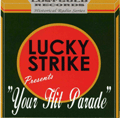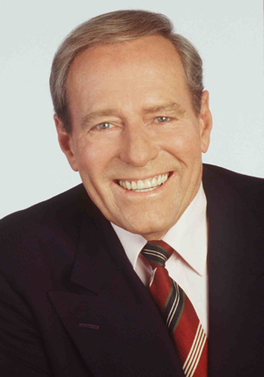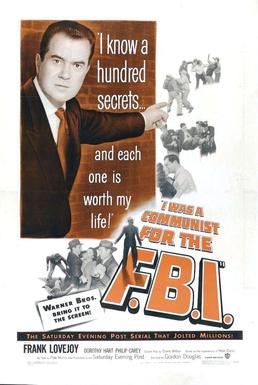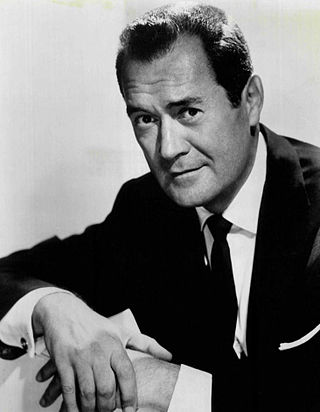Related Research Articles

Radio drama is a dramatized, purely acoustic performance. With no visual component, radio drama depends on dialogue, music and sound effects to help the listener imagine the characters and story: "It is auditory in the physical dimension but equally powerful as a visual force in the psychological dimension." Radio drama includes plays specifically written for radio, docudrama, dramatized works of fiction, as well as plays originally written for the theatre, including musical theatre, and opera.

Your Hit Parade was an American radio and television music program that was broadcast from 1935 to 1953 on radio, and seen from 1950 to 1959 on television. It was sponsored by American Tobacco's Lucky Strike cigarettes. During its 24-year run, the show had 19 orchestra leaders and 52 singers or groups. Many fans inaccurately referred to the show as The Hit Parade.

Portia Faces Life, is an American soap opera first broadcast as a radio series from 1940 to 1953, and then on television for a single season in the mid-1950s. It began in syndication on April 1, 1940, and was broadcast on some stations that carried NBC programs, although it does not seem to have been an official part of that network's programming. The original title was Portia Blake Faces Life.

Philip Carey was an American actor, well-known for playing the role of Asa Buchanan on the soap opera One Life to Live for nearly three decades.

The Aldrich Family, a popular radio teenage situation comedy, was also presented in films, television and comic books. In the radio series' opening exchange, awkward teen Henry's mother called, "Hen-reeeeeeeeeeeee! Hen-ree Al-drich!", and he responded with a breaking adolescent voice, "Com-ing, Mother!"

Mr. District Attorney is a radio crime drama produced by Samuel Bischoff that aired on NBC and ABC from April 3, 1939 to June 13, 1952. The series focused on a crusading district attorney initially known only as Mister District Attorney or Chief, and was later translated to television. On television, the attorney's name was Paul Garrett, and the radio version adopted the name in its final years when David Brian played the role. A key figure in the dramas was secretary Edith Miller.

I Was a Communist for the FBI is a 1951 American film noir crime film directed by Gordon Douglas and starring Frank Lovejoy. The film was produced by Bryan Foy who was head of Warners B picture unit until 1942.

Frank Andrew Lovejoy Jr. was an American actor in radio, film, and television. He is perhaps best remembered for appearing in the film noir The Hitch-Hiker and for starring in the radio drama Night Beat.
Peter George Derek Ling was a British writer of television, radio and comic strips, best known for his television work. With his professional partner, Hazel Adair, he co-created the television soap opera Crossroads.

One Man's Family is an American radio soap opera, heard for almost three decades, from 1932 to 1959. Created by Carlton E. Morse, it was the longest-running uninterrupted dramatic serial in the history of American radio. Television versions of the series aired in prime time from 1949 to 1952 and in daytime from 1954 to 1955.

My Little Margie is an American television situation comedy starring Gale Storm and Charles Farrell that alternated between CBS and NBC from 1952 to 1955. The series was created by Frank Fox and produced in Los Angeles, California, at Hal Roach Studios by Hal Roach Jr., and Roland D. Reed.

Dorothy Collins was a Canadian-American singer, actress, and recording artist.

The Paramount Television Network was a venture by American film corporation Paramount Pictures to organize a television network in the late 1940s. The company built television stations KTLA in Los Angeles and WBKB in Chicago; it also invested $400,000 in the DuMont Television Network, which operated stations WABD in New York City, WTTG in Washington, D.C., and WDTV in Pittsburgh. Escalating disputes between Paramount and DuMont concerning breaches of contract, company control, and network competition erupted regularly between 1940 and 1956, and culminated in the dismantling of the DuMont Network. Television historian Timothy White called the clash between the two companies "one of the most unfortunate and dramatic episodes in the early history of the television industry."

Strike It Rich is a game show that was broadcast on American radio from June 29, 1947 to December 27, 1957, on CBS and NBC. It was broadcast on television as well, starting in 1951. People in need of money appeared and told their tale of woe, then tried to win money by answering four questions. If the contestant did not win any money, the emcee opened the "Heart Line", which was a phone line to viewers who wished to donate to the contestant's family.

Nick Carter, Master Detective was a Mutual radio crime drama based on tales of the fictional private detective Nick Carter from Street & Smith's dime novels and pulp magazines. Nick Carter first came to radio as The Return of Nick Carter, a reference to the character's pulp origins, but the title was soon changed to Nick Carter, Master Detective. A veteran radio dramatist, Ferrin Fraser, wrote many of the scripts.
Just Plain Bill was a 1932-1955 15-minute American radio drama program heard on CBS Radio and NBC Radio. It was "a story of people just like people we all know.”

Casey, Crime Photographer, known by a variety of titles on radio was a media franchise from the 1930s to the 1960s. The character was the creation of novelist George Harmon Coxe. Casey was featured in the pulp magazine, Black Mask, novels, comic books, radio, film, television and legitimate theatre.
Gang Busters is an American dramatic radio program heralded as "the only national program that brings you authentic police case histories." It premiered on January 15, 1936, and was broadcast over 21 years through November 27, 1957.

This is a comprehensive listing of the radio programs made by Orson Welles. Welles was often uncredited for his work, particularly in the years 1934–1937, and he apparently kept no record of his broadcasts.
Radio is what I love most of all. The wonderful excitement of what could happen in live radio, when everything that could go wrong did go wrong. I was making a couple of thousand a week, scampering in ambulances from studio to studio, and committing much of what I made to support the Mercury. I wouldn't want to return to those frenetic 20-hour working day years, but I miss them because they are so irredeemably gone.
Betty Mandeville was one of the first female producers and directors in American network radio. She worked in television later in her career.
References
- ↑ Cox, Jim (2002). Radio Crime Fighters: More Than 300 Programs from the Golden Age. McFarland. p. 109. ISBN 9781476612270 . Retrieved 6 August 2016.
- ↑ Dunning, John (1998). On the Air: The Encyclopedia of Old-Time Radio (Revised ed.). New York, NY: Oxford University Press. p. 245. ISBN 978-0-19-507678-3 . Retrieved 2019-09-30.
- ↑ "The Busy Air". Time. February 7, 1955. Archived from the original on December 15, 2008. Retrieved January 7, 2009.
- ↑ Bergman, Elizabeth. "Sergei Prokofiev The FBI March". The Serge Prokofiev Foundation. Retrieved August 30, 2014.